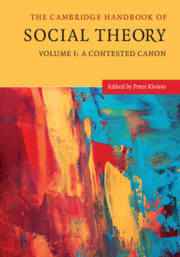Book contents
- The Cambridge Handbook of Social Theory
- The Cambridge Handbook of Social Theory
- Copyright page
- Contents
- Figures
- Tables
- Contributors
- Preface
- 1 The Emergence of Social Theory
- 2 “What Is a Classic?”
- 3 Karl Marx
- 4 The Marxist Legacy
- 5 Émile Durkheim: Theorist of Solidarity
- 6 What’s in a Name?
- 7 Max Weber
- 8 Weberian Social Theory
- 9 Georg Simmel and the Metropolitization of Social Life
- 10 Pounding on Parsons: How Criticism Undermined the Reputation of Sociology’s Incurable Theorist
- 11 Symbolic Interactionism
- 12 Erving Goffman and Dramaturgical Sociology
- 13 Structuralism
- 14 Norbert Elias, Civilising Processes, and Figurational (or Process) Sociology
- 15 Phenomenology and Social Theory
- 16 Pierre Bourdieu: An Intellectual Legacy
- 17 Developing Ethnomethodology: Garfinkel on the Constitutive Interactional Practices in Social Systems of Interaction
- 18 Jürgen Habermas
- 19 Anthony Giddens, Structuration Theory, and Radical Politics
- Index
- References
13 - Structuralism
Published online by Cambridge University Press: 03 December 2020
- The Cambridge Handbook of Social Theory
- The Cambridge Handbook of Social Theory
- Copyright page
- Contents
- Figures
- Tables
- Contributors
- Preface
- 1 The Emergence of Social Theory
- 2 “What Is a Classic?”
- 3 Karl Marx
- 4 The Marxist Legacy
- 5 Émile Durkheim: Theorist of Solidarity
- 6 What’s in a Name?
- 7 Max Weber
- 8 Weberian Social Theory
- 9 Georg Simmel and the Metropolitization of Social Life
- 10 Pounding on Parsons: How Criticism Undermined the Reputation of Sociology’s Incurable Theorist
- 11 Symbolic Interactionism
- 12 Erving Goffman and Dramaturgical Sociology
- 13 Structuralism
- 14 Norbert Elias, Civilising Processes, and Figurational (or Process) Sociology
- 15 Phenomenology and Social Theory
- 16 Pierre Bourdieu: An Intellectual Legacy
- 17 Developing Ethnomethodology: Garfinkel on the Constitutive Interactional Practices in Social Systems of Interaction
- 18 Jürgen Habermas
- 19 Anthony Giddens, Structuration Theory, and Radical Politics
- Index
- References
Summary
As a theoretical perspective, structuralism focuses on the notion of structure. This notion can be defined in two distinct ways. The intentional definition directs attention to a system of empirically observable relations among the members of a given collectivity, as indicated by their roles and social positions. The effective definition conceives of structure as a set of interrelated but not visible elements, the study of which calls for a special method of inquiry. This method has been applied to anthropology, linguistics, literature, and psychology. Radcliffe Brown, Merton, Lipset, Coleman, and Blau are among the foremost representatives of structuralism intentionally defined. De Saussure, Lévi-Strauss, Barthes, and Althusser, among others, represent structuralism effectively defined.
Sandro Segre is a retired professor of sociology and sociological theory, which he taught at the University of Genoa. Some of his recent publications include Bauman, Elias, and Latour on Modernity and Its Alternatives (2020), Business and Financial Markets: A Weberian Analysis (2016), Contemporary Sociological Thinkers and Theories (2014), Introduction to Habermas (2012), and Talcott Parsons: An Introduction (2012).
- Type
- Chapter
- Information
- The Cambridge Handbook of Social Theory , pp. 250 - 271Publisher: Cambridge University PressPrint publication year: 2020

